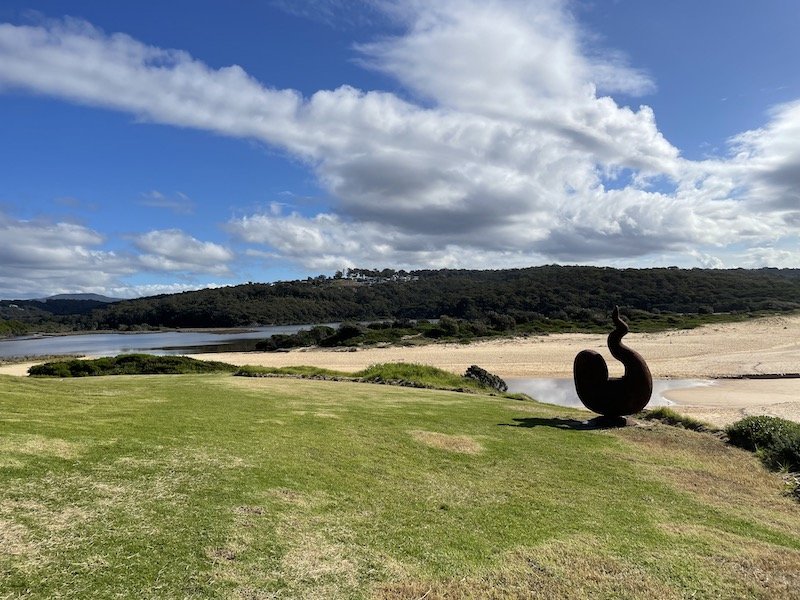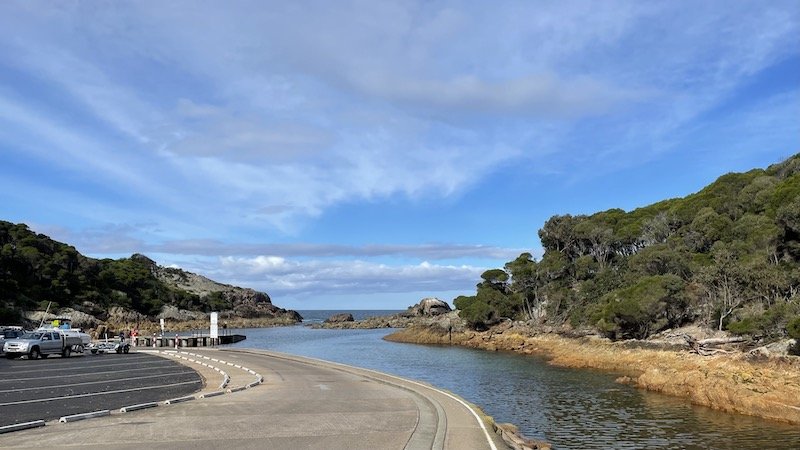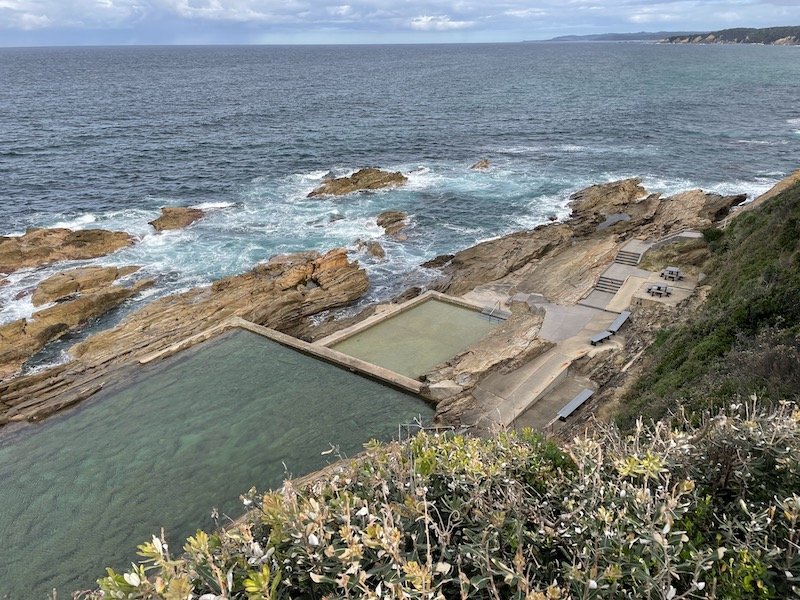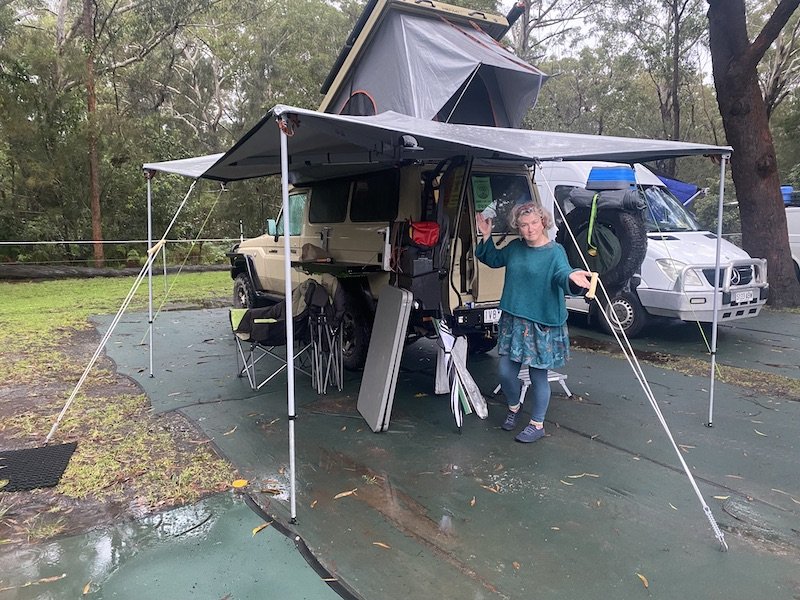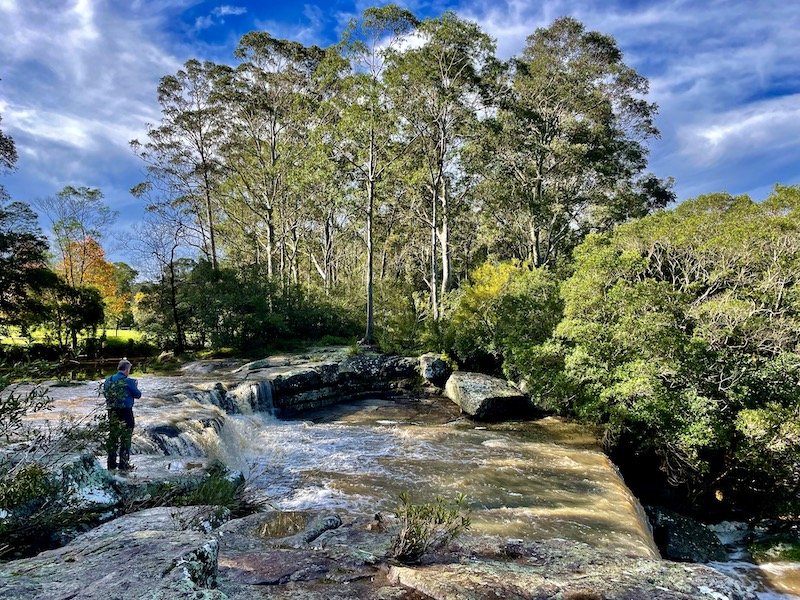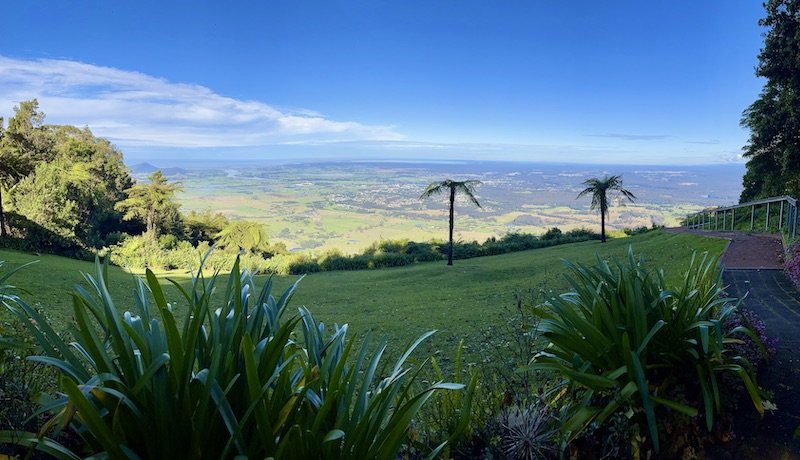Up past Sydney
We had mostly rain with the occasional bright spell giving us a few rainbows as we headed up the East Coast so we didn’t explore the seaside as much as we had planned. Our first stop was the the little settlement of Merimbula on Djiringanj Country. The name, which may have been Anglicised from Merimboola, is thought to mean ‘place of two waters or lakes’ and refers to the Merimbula Lake and the Back Lagoon, both formed by rivers obstructed by shifting sand bars at the mouth similar to the one at Mallacoota. In between these is a rocky peninsula, with unequal promontories descriptively named Short Point and Long Point, flanked by golden beaches stretching north and south. The photos show the Back Lagoon to the left with the sometimes-open channel over Tura Beach to the sea and the flat rock platforms of Short Point.
The combination of fresh and salt water as well as rock pools, beaches and forest would have provided plentiful food, medicinal plants and useful things as described by a Djiringanj Elder who hints at the reciprocity Indigenous people had with the land, water and sky.
"You get Bimbalas in the lakes, oysters and Barawili on the rocks and Mudawa on the beach.
Geebung berry is good for stomach ailments.
Black Wattle bark is a sedative and used to stun mullet.
Pigface leaves were wrapped around fish while it was cooking to give a salty flavour
Bones of the mutton bird and Burran are used for jewellery.
Pipis on the beach, mullet, bream, eel, we only take what we need. Near this Balindjang (salt water) place there would be fresh water also. Rich Food area.”
Djiringanj Elder Auntie Colleen Dixon, 2018
Throughout our travels here we have used the wikicamps app which is populated by users who can add ‘places of interest’ as well as camp spots and other helpful stuff like places to launch you boat, fill you water tanks and empty your loo. One of these places was just labeled ‘Huge Sting Rays At Docks!’ so we had to have a look. It was true, there were at least ten Rays at the ramp that had followed the little fishing boats in and were waiting for scraps from the cleaning tables. The friendly fishers gave Ian some food and advised him how to feed them and up they came to take it from his hand. Watch the action here.
This part of the country has been labeled The Sapphire Coast for tourist purposes, an interesting marketing technique that makes it easy to group places, experiences and information about a geographical area all rolled up in an enchanting name that makes you want to explore it. Before we learned this fact, we spotted a couple of other ‘places of interest’ on Wikicamps that we turned off to visit. At Bermagui where, back in the 1930s a natural tidal pool, known as the Blue Hole, was enlarged to a length of around 75m to make a swimming facility suitable for training and competition swimming. The project was the idea of a local philanthropist, Bill Dickinson, who contributed significant private funds which in turn attracted government grants and charitable donations. Rock was blasted out with dynamite and local labour shovelled the spoil out into the sea and concrete was used to square off one end, build a children’s wading pool and steps down the cliff path. The Hole was renamed The Blue Pool and is now considered one of the best sea water pools in Australia. These photos were taken of the information board near the pool but there was no acknowledgement provided.
The pools are refreshed at every high tide and have excellent water quality, including lots of sea creatures, some that live in there all the time and others who come and go with the tides. Today, the act of blasting the coastal environment in this way feels like violent vandalism and, if such a proposal were even made now, it would not be undertaken. But the half natural half manmade structure is here and cannot be returned to its original state without further destruction. Whatever you think of what was done to the Blue Hole, it forms part of the history of the area and is a wonderful place to safely swim and enjoy the sea. With this in mind, it is being well maintained both as a marine environment and a leisure facility and now has modern changing amenities. It was actually closed to the public for maintenance when we were there which was a shame as I’d have enjoyed a dip.
Blue Pool, Burmagui, NSW
Near the steps to the Blue Pool was a striking piece of street art. This wonderful mural on the Bermagui Water Tower was reproduced from an original piece of artwork painted by indigenous artist, Joe McKenzie. It’s called ‘Sprit Dance’ and was painted in an attempt to help Mr McKenzie’s young sons, Latrell and Kobe, to get to sleep, with its friendly protective spirits that ward off bad spirits. It was the inaugural winner of the $500 Bega Valley Mural Prize for 2017 and McKenzie’s success was considered particularly noteworthy given he had only recently taken up painting. It’s lost a bit of the vibrant colour shown in the slightly blurred photo (taken from the Bega Valley website) since it was originally painted but I’m sure the sprits are still doing their job.
lt poured with rain as we headed north but we had a brief break in the clouds to set up camp at Mystery Bay. The dry spell lasted just long enough to cook on the campfire but we ended up looking at it from under our awning. The next morning there was a break long enough to take in the beauty of fallen flowers, tiny shells and colours of the rocks and and lichen. Having the time to look closely and dwell of the wonder of the natural world has been a great privilege on this trip and I’m pleased to share a little of it here.
The coastal town of Narooma is a good example of how man-made structures have been developed to resist long shore drift and keep a navigable waterway open. Here they have built a pair of rock groins at right-angles to the beach to form a channel allowing boats to enter a little harbour and head up the river. Next to these is a rock window formation in the cliff called Australia Rock. You have to use your imagination a bit but it does resemble the outline of Australia, at least for the time being.
We had some advice from a fellow traveller who kindly listed a few places worth visiting which included Murramarang National Park. We booked into North Head campground and set off down a really muddy dirt track through the bush. Just as we were setting up, a young couple turned up and we invited them to share our fire and awning as they had no shelter other than their roof-top tent. We all had a good laugh together looking out at the fire and rain once again and sharing travel stories and plans. We were both heading north and thought we’d be on K’Gari (Fraser Island) at the same time so swapped details in the hope of meeting up again.
North Head campground, Batemans Bay, NSW
The rain put paid to our next planned bush camp when we had to turn back as the risk of getting stuck up to the axles in mud was a distinct possibility so we rolled into Jervis Bay Holiday Park and took the last but one spot. The difference between campgrounds and caravan parks is the amount and quality of the facilities. The former may only be an unmarked space in the bush, perhaps with a long drop toilet, they are mostly spacious and free or cheap (less than $20 a night). Whereas the latter generally have flushing loos, showers, a laundry, and maybe a games room and swimming pool but they are usually cramped and expensive ($40-100 a night). We are way more interested in having lots of space in a natural environment and spending less money than any bells and whistles so we don’t often stay on caravan parks. The one time when good facilities are really welcome is when the weather is relentlessly wet because, in a small space like the Troopy, no matter how careful you are, everything starts to get damp. Having made the exact same decisions, Mac and Kim took the last spot and we waved across the puddles before turning in for the night.
Jervis Bay Caravan Park, Jervis Bay, NSW
Once you get on a main road, it can be easy to whizz past interesting places, especially as many that were on the original old main road are not visible from the freeway. We seek out interesting things to look at to break up drives like this and found one so close to the road but with the feeling we were miles from it. Paddle Creek Falls is a series of broad faults in the river bed providing a pretty scene and multiple swimming holes. The water was flowing fast and muddy due to all the rain so not great for a dip but a nice walk nevertheless. The cars speeding by with drivers oblivious to the beauty they were missing just meters away was a strange experience, it made us feel we were party to a well kept secret.
Paddle Creek Falls, NSW
Another stopping point was a lookout in the Camberwarra Nature Reserve on the eastern edge of the Great Dividing Range between Kangaroo Valley and Berry Bay with a view across the patchwork of now farmed land but which would one have been forest, towards the sea. Cambewarra was given its name by the traditional custodians of this area, the Dharawal People who were expert hunter-fisher-gatherers living off the land in family groups and clans along the coastal area of what is now known as Sydney Basin. Cambewarra Mountain was given a name meaning 'mountain of fire' because it was thought to have once been a volcano. Another reason for the name is that cloud usually shrouds its summit - even on a clear day there often appears to be smoke coming from the top. We visited during a clear sunny spell so ate our picnic while taking in the scenery.
Cambewarra Mountain, NSW
My mum, Eileen, was born in Melbourne in 1922, the middle child of five daughters who between them had 20 children of which I am the youngest and my brother Ken is the eldest. I didn’t grow up near any of my cousins so never got to know them and some I have only met once when I came to Australia with Mum as a child in 1976, so this trip has provided an opportunity to meet a few ‘rellies’. We stayed a couple of nights with my cousin, David, and wife, Fran, in Wollongong, just south of Sydney, where we were able to set up the Troopy in their beautiful garden.
David and Fran’s garden, Wollongong, NSW
David has spent many years working in forest protection, conservation and restoration projects which are very close to my heart so it was great to hear about this as well as learn a bit about his mum, Eileen’s youngest sister, Helen, and her branch of the family. He had this photo of the three eldest girls, mum is in the middle. Whilst her sisters both had long hair, mum was considered a bit weedy so her hair was kept short lest it sapped her strength to grow it. I can tell you, there was nothing remotely weedy about my mum, so maybe it worked!
Win, Eileen and Di Newman 1923/4
Without any planning or forethought, our visit to David and Fran’s coincided with the annual Wollongong Comic Gong festival, the first for three years because of the pandemic. It’s an opportunity for people to have great fun dressing up as comic book characters and doing all sorts of stuff related to comics and super heroes. There was also lots of street music and David, who is a very accomplished musician, performed a couple of sets with one of the bands playing guitar, trombone and singing. We also got to see him play a very different performance with a big band the following day at the bowls club. I was very proud to watch and pleased to join this little slice of family life.
We briefly called into Sydney where we had brunch with another cousin, David’s older brother, Stephen and his wife Rosie who live right in the heart of the city in a house which doubles up as Rosie’s millinary business where she makes hats which you have most probably seen in the movies. For some reason, the only photo I have of this visit was this one of an amazing tree near their home. It just means we will need to go back another time to take more!
We stayed in the northern suburb of Dee Why with an previous work colleague of Ian’s from the UK, Liz and husband Ian. On their advice we caught the river bus from McMahons Point Wharf which took us under Sydney Harbour Bridge across to the Opera House precinct to have an ice cream.
When we were in Australia in 2007 with our four children, we took them to a performance of Il Travatore at Sydney Opera House, an experience they all recall despite being jet-lagged teenagers at the time. Both the bridge and the opera house are stunning structures and the river is a great place to view them from especially in the evening light.
On our way out of Sydney, we called in to stay with Ian’s Auntie Lorraine who lives in Glenmore Park, one of the Western suburbs. We had a lovely time learning more about a branch of Ian’s Mum’s family this time. We planned to meet her and her son at Hollydene Estate Winery in the Hunter Valley a few days later. We have deliberately avoided the numerous wineries, breweries and distilleries on our travels mainly because we can’t justify spending so much money on alcohol and most of the food served at the cellar door to go with tasting experiences is meat, cheese and biscuits which we don’t eat. On this occasion, there was a lunch menu and a pretty garden that came highly recommended by Lorraine, so we made and exception.
Hollydene Estate Winery
Before European Settlement in Australia the Wonnarua Koori People inhabited most of the Hunter Valley Region. The rich fertile land, rivers and skys where they were custodians was one of the first areas outside Sydney to be settled by the English in the 1820s as more land was sought for agriculture. There is evidence in the form of personal journals indicating that explorers engaged Aboriginal guides to navigate through the dense bush and negotiate safe passage through Country of neighbouring clans. It is unclear whether individual guides were forced to undertake this task or if they chose to engage for self protection or possibly in the hope that the settlers would go elwhere and leave their Country alone.
When I write these blogs I often disappear down internet rabbit holes when I want to understand things and sometimes end up reading around a subject for hours. On this occasion, I found it really hard to understand why Aboriginal people would help the invaders who were trashing their home and killing their people. It turns out that others have sought to understand this about Aboriginal and other indigenous people around the world too and I found that this open-access book available online brings together much of their research and I found it fascinating.
Once the settlers saw the valley, it was considered prime farming land and the river frontage was divided up and granted to wealthy people from Sydney. The first explorers blazed the trail with tree markings so others could follow, which actually assisted some escaped convicts, much to the irritation of the penal colony commandant. As the new ‘land owners’ arrived, the Wonnarua Koori People were driven away from their food and water sources and their sacred sites. Many died in conflicts with settlers and as a result of introduced diseases. Those who survived were forced to live on mission settlements and prevented from undertaking their cultural and spiritual activities or speaking their language. Later they were introduced to alcohol and tobacco which led to addiction and further ill health that remain disproportionally high amongst the Aboriginal Peoples today.
Not content with stealing Country, settlers went on to damage it further with the introduction of extractive industries on a massive scale which started in the 1800s and continue at full pelt today. In the Hunter Valley, amongst the lush vineyards but hidden from public view, there are forty one gigantic mostly open cut mines that are destroying habitat and sites of Aboriginal cultural significance. Despite the overwhelming evidence that fossil fuel use must cease in order to prevent catastrophic climate breakdown, demand from emerging economies that far outweighs the reduction of coal use in Europe is ensuring that such mines continue ‘business and usual’ and international mining companies are even planning on expanding their operations. Given this fact, alongside the shear scale, intensity and duration of the intergenerational trauma caused by colonisation, you would think, wouldn’t you, that a halt would be called to inflicting further suffering.
Open cut coal mines in the Hunter Valley - an ulcer on the face of beautiful Country
One of the lovely aspects of our travels has been meeting fellow travellers, may of whom, like Mac and Kim, we have crossed paths with several times. Others have kindly invited us to their homes should we pass by and one such couple were Catherine and Irene who we camped next to at Marysville on our Troopy Shakedown trip. They are amongst a growing group of people who incorporate house-sitting into their travel plans. When we visited them in Newcastle, they were caring for the home and little dog of a friend near their previous home but were in the process of lining up their next location for someone who had advertised for a sitter. There are agencies that match owners and sitters, which is more comfortable for all parties and allows a bit more forward planning. The arrangement is generally free and provides a welcome break from being on the road as well as an opportunity to care for a pet. Here is a great picture of Irene demonstrating an exercise to help manage the sciatic pain I was experiencing with the help of the pup they were minding!
Join us next time as we make a loop inland along the Waterfall Way.
